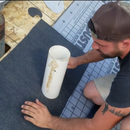Condensation under metal roofing
If it is common for condensation to form under metal roofing, and it is also common to NOT flash or waterproof any penetrations at the roof deck level (before roofing is installed), how can one be certain no amount of moisture/condensation is going into the hole cut out for a vent pipe underneath the roofing?
When I do my roof, I plan to cut out a piece of ice and water shield to fit over my pipes (see picture) but even this isn’t water tight probably, unless perhaps there’s caulking around the joint where the ABS (or other penetration) and ice and water shield meet… even then that’s going to fail eventually or not stick at all (the sealant), especially in the case of a polypropylene face of an ice and water shield.
Roofers in my area don’t worry about this, at least of the roofers I’ve talked to. They say they just put the decktite/roof pipe flashing over the pope and seal it to the metal roof. Nothing more, nothing at the deck/sheathing level.
Am I wrong to be concerned about all this? I’m in zone 4c and have a vented system, soffit to ridge. No insulation in the rafters just insulation filling the ceiling joist bays.
GBA Detail Library
A collection of one thousand construction details organized by climate and house part










Replies
Kevin,
Yes it is good practice to seal the underlayment at all penetrations.
On a metal roof installed directly on impermeable underlayment and sheathing there is a very small gap where the are ridges in the panels, and none on the rest. That means there is almost no moist air below the roofing to condense - a quite different situation from roofs with a deliberate vented space above the sheathing.
Here is how I deal with roof vents from your other thread: https://www.greenbuildingadvisor.com/question/low-slope-metal-roof-underlayment
I suppose roofers ignore this detail because of a combination of ignorance on the customers part and time and material...
What are your thoughts on pencil ribs then, vs. a flat profile for the panels? Based on what you said it seems a flat panel is better because without pencil ribs there’s even less air sneaking in. Thoughts?
All I’ve ever heard of when comparing the different profile options is flat reveals discontinuities in the sheathing (h clips, irregular framing, etc.) while pencil ribs acts like drywall texture to hide discontinuities while also adding rigidity to the panel, allowing one to save $ by getting lighter gauge over the thicker gauge... For example a 26g v 24g
Kevin,
The panels need some profile to allow for movement. Apart from corrugated metal I don't think there is much to choose between them. The two suppliers I use have bead ribs. The cavity underneath is probably 3/32" high, holding a negligible amount of moist air. The photo is from my shed.
I would stay away from flat panels unless you go heavy gauge. Flat panel is asking for oil canning.
You want the most amount of air under the metal roof, even with closure strips, this gap allows for some amount of ventilation which helps to clear condensation.
I've never done much more than seal the plumbing stack with a boot to the roof panel, Malcolm's suggestion of a square piece to the underlayment definitely feels better.
I agree with you there about Malcolm’s suggestion. Do you think though that with a ‘cut out hole’ in a piece of ice and water shield just smaller than the pipes’ diameter is actually watertight? Or is it watertight enough for ‘underside of roof condensation amounts moisture’?
If not, what are your thoughts on a bead of sealant where the pipe meets that piece of underlayment/ice shield that is slid onto pipe? Anything you know of that’ll stick to polypropylene (That’s the non sticky side of my ice and water shield)??? Rated for higher temps...
Or possibly a sealant made of it’s adhesive - SBS modified bitumen. That would HAVE to stick to the polypropylene face, right?